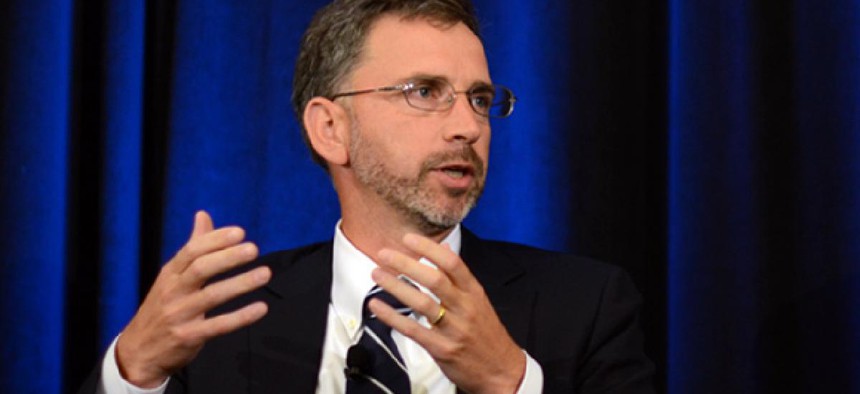
GSA Chief Dan Tangherlini Caitlin Fairchild/GovExec.com
Does it take an emergency to get federal agencies to work together?
Top Obama officials examine barriers to interagency collaboration.
The holy grail of reaching goals through interagency collaboration requires a new culture and visible leadership by political appointees, and is currently realized more often during government emergencies than in day-to-day federal work life.
So asserted executives from the General Services Administration, the Office of Personnel Management and other Obama administration officials tasked with reducing homelessness, at a conference on Wednesday cross-agency management put on by the newsletter FedInsider at The George Washington University.
Superstorm Sandy “is the type of situation that is ideal for leveraging the scale of the federal government to make it a center of excellence,” acting GSA chief Dan Tangherlini told the audience of federal managers. “The leveraging depends on existing relationships” among agencies, ones that GSA exploited this fall when it was called on by the Federal Emergency Management Agency to partner with states, localities and the private sector to rush emergency supplies to victims of the hurricane. An example was GSA’s longtime relationship with General Electric, which allowed federal employees, many of whom were restricted to mobile devices for communication because offices were closed, to locate a rare spare part for an idled and damaged New York City subway car. GSA also helped Con Ed restore power to affected parts of New Jersey and New York by arranging for police-protected sleeping accommodations for out-of-town repair crews arriving to do cleanup.
The key to collaborating, Tangherlini said, is “to worry less about hierarchy than [about] outcomes and results, worry less about the organizational chart and focus on the common mission of service to the community.” The ongoing challenge, he added, is to apply such principles to “the everyday work” of government.
Tangherlini also reported on interagency input to GSA’s Challenge.gov website that for two years has been collecting cost-saving solutions. It has received 215 challenges from 48 agencies, along with 5,000 proposed solutions from 108,000 participants, many of them members of the public.
Interagency collaboration “should be thought of not as a tool but a mind-set that, with practice, becomes part of who you are,” said Kathryn Medina, executive director of OPM’s Chief Human Capital Officers Council. Such collaboration can be “inconvenient,” she said, as when an employee based in Hawaii in a different time zone has to be included in conference calls. When she arrived at OPM from the private sector in 2009, she added, she was baffled at the large number of federal employees who attended many meetings.
It’s the political appointees who must be accountable for pushing employees to cross cultures in an interagency effort as well as to cut losses when clashing parties “sabotage” the effort, Medina said.
She described two interagency success stories: the recent establishment of the Web-based Human Resources University as a central place for federal workers to map their careers using free training provided by 12 specialized agencies such as NASA and the Treasury and Homeland Security departments and the pilot goals, engagement, accountability and results (GEAR) system of performance reviews assembled by the chief human capital officers in cooperation with the National Council on Federal Labor-Management Relations. The Human Resources University now has 16,000 regular users and has saved the government $35 million, she said. GEAR has encouraged continuous feedback from managers to employees rather than just annual reviews, Medina noted.
The Obama administration’s priority goal of reducing homelessness -- particularly among the thousands of veterans returning from the wars in Iraq and Afghanistan -- prompted a detailed discussion. Barbara Poppe, executive director of the U.S. Interagency Council on Homelessness, described the work of her council’s staff of 20 in coordinating 19 agencies that have been working together on the problem since the late 1980s, notably Housing and Urban Development and the Veterans Affairs departments, as well as the Office of Management and Budget.
She described how HUD and the VA resolved their differences on how to count the homeless and make databases interoperable. “People in their jobs tend to be experts, so when we ask them to collaborate, the process is much more messy than just doing what you’re told to do,” Poppe said. “But the best collaboration is not top-down but horizontal.”
Lisa Danzig, director of strategic planning and management and performance improvement at HUD, said, “People can be overwhelmed if there’s too much collaboration -- it’s not a natural thing to do.” She said it helps that HUD Secretary Shaun Donovan and Veterans Affairs Secretary Eric Shinseki have a “strong relationship.” She cited as a good example of the necessary “silo busting” HUD’s work in distressed cities such as Detroit and New Orleans, where the department roped in Fannie Mae and Freddie Mac to help potentially homeless households avoid foreclosures and working with “regional planners to find solutions that are least burdensome to neighborhoods.”







